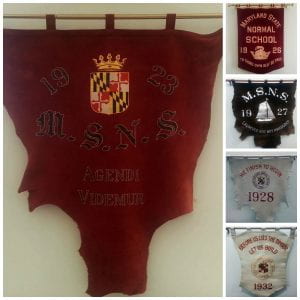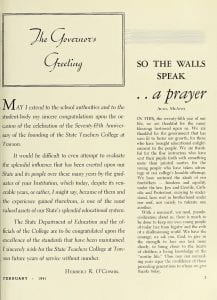For about 50 years, Towson celebrated a now little-known anniversary, the very first day of classes at the Maryland State Normal School in January of 1866.
The celebration, called Founders’ Day, is first in evidence in the school calendar for 1919/1920 when the Maryland State Normal School principal was Henry Skinner West. By that time, the school was at its Towson location, and West was working to build up enrollment. Part of his efforts included engaging more with the outside community, and perhaps this celebration did that as well as underscored the importance of the school’s history to its members.
Under West’s successor, Lida Lee Tall, the Founders’ Day events reached their heyday. The first record of how the school celebrated can be found in a Towerlight article from 1924. “Miss Tall the principal, gave the opening address, speaking of the history of the school since its founding. She then introduced Mr. [Albert S.] Cook, who after a few brief remarks, introduced the main speaker, Dr. A.E. Winship. Dr. Winship, having known Dr. Newell personally, gave a splendid eulogy of his ability, earnestness and integrity. He said that his whole soul was wrapped up in his work and the results which he achieved and which we view today were accomplished by hard work.”
By the 1930s, the Founders’ Day events were often hosted by the senior class or Alumni Association, and the programs consisted of speeches, music, refreshments and dances.

They showcase mottoes from various classes.
“One of the most important and impressive assemblies of the year was that held on Friday, January 16, commemorating the dedication of the Normal School in 1876,” reported the Towerlight in February of 1931. “The auditorium was beautifully decorated with palms and reproductions of old mottoes.
“The programs were especially interesting in that the original program was printed on one side and the adaptation opposite, the adaptation following the original as closely as possible.”
That evening, the Alumni gave a dance for the seniors. “Between eight and nine o’clock the receiving line . . . welcomed the old and experience alumni, and many, many gay and vibrant Seniors. Excitement and friendliness were in the air. The usual formal business office was transformed into a bower of flowers, lighted candles, and soft colored tapestries and prints. Punch and cookies were served in Miss Tall’s private office by several charming Juniors.”

were printed in the next month’s Towerlight.
The program for each Founders’ Day seemed to follow the same pattern — someone would focus on a specific part of the school’s history whether it be M.A. Newell’s contributions or the dedication ceremonies for the buildings both at the Carrollton Avenue location and the Towson one, then there would be a speaker to talk about the progress of education, and in between there would be numbers performed by the chorus or orchestra or soloists. Finally everyone would gather for refreshments, and there might be a dance, or it just might be tea.
When Earle T. Hawkins was President of the school, the programs began to change. They became part of a mid-winter convocation and except for big anniversary events, Hawkins used the time to address the students about matters relating to education as a whole rather than specific moments in the school’s history. During the Ninetieth and Centennial celebrations, however, Maryland Governors and other officials attended and offered greetings and congratulations before the main guest speakers took the stage to talk again about the development of teacher education.
By the early 1960s, this model was becoming more and more obsolete as both the student body and the programs offered changed. Hawkins spent more time offering life lessons and urging students to become more involved with the world both on and off campus. “Hawkins Blasts Student Apathy” blared one Towerligh headline in January of 1962. “What this nation needs is energetic, informed young people,” the paper quoted Hawkins as saying.
The last Founders’ Day celebration was held in January of 1966. It celebrated the school’s 100th anniversary, and the dedication of Smith Hall by Governor J. Millard Tawes. After a lecture about new trends in education by the education editor of the New York Times, Fred Hechinger, a portrait of Dr. Hawkins was presented by the Alumni Association. “After the ceremony, faculty members, guests, and students enjoyed a buffet-style luncheon in the college cafeteria,” reported the Towerlight.
